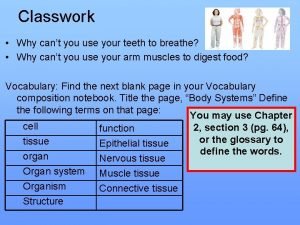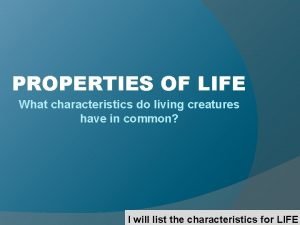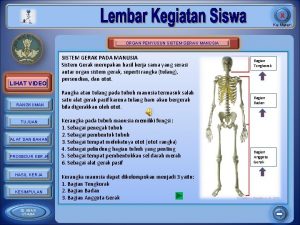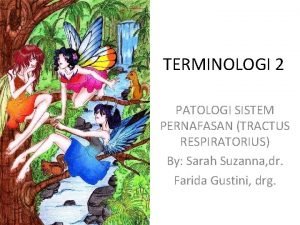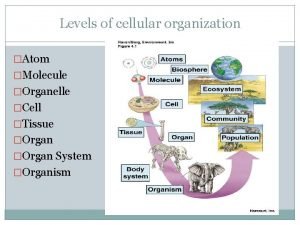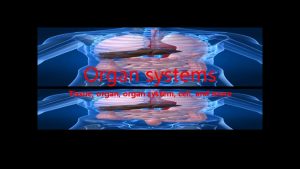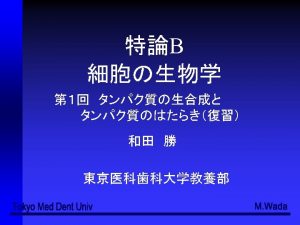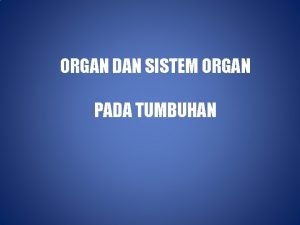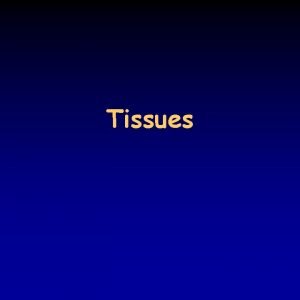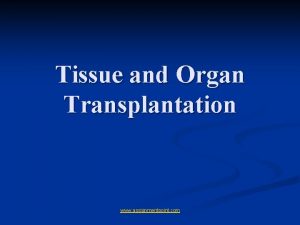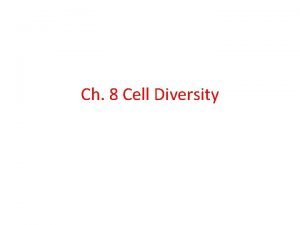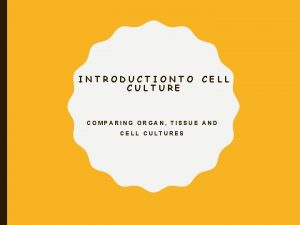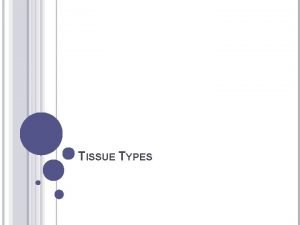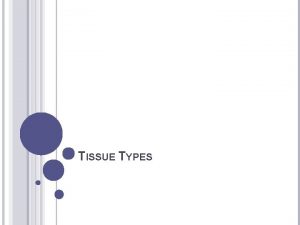Tissue Cell Organ Cell The cell is the























- Slides: 23


Tissue Cell Organ

Cell : • The cell is the basic structural and functional unit of all known living organisms. It is the smallest unit of life that is classified as a living thing, and is often called the building block of life. • Organisms can be classified as unicellular (consisting of a single cell; including most bacteria) or multicellular (including plants and animals). • Humans contain about 10 trillion (1013) cells. Most plant and animal cells are between 1 and 100 µm and therefore are visible only under the microscope. [ The cell was discovered by Robert Hooke in 1665. The cell theory, first developed in 1839 by Matthias Jakob Schleiden and Theodor Schwann, states that all organisms are composed of one or more cells, that all cells come from preexisting cells, that vital functions of an organism occur within cells, and that all cells contain the hereditary information necessary for regulating cell functions and for transmitting information to the next generation of cells.

Cell is the basic unit of life and all the life forms mainly consists up of c They are the building blocks of an organism. Classification of cell ANIMAL CELL & PLANT CELL Classification on basis of modificaton EUKARYOTIC CELL & PROKARYOTIC CELL

Plant And Animal cell ANIMAL CELL PLANT CELL

Eukaryotic cell: The cell that have a well defined nucleus, nucleolus and all types of cell organells. Prokaryotic cell: The cell that don’t have a well defined nucleus, nucleolus and cell organells. ANIMAL CELL

PROKARYOTIC CELL EUKARYOTIC CELL

CELL ORGANELLS Cell wall Cell/plasma membrane Nucleus Mitochondria Endoplasmic Reticulum Golgi apparatus Lysosomes Vacuoles

Cell Wall �Many types of prokaryotic and eukaryotic cell have a cell wall. The cell wall acts to protect the cell mechanically and chemically from its environment, and is an additional layer of protection to the cell membrane. Different types of cell have cell walls made up of different materials; plant cell walls are primarily made up of pectin, fungi cell walls are made up of chitin and bacteria cell walls are made up of peptidoglycan


Cell membrane �The cytoplasm of a cell is surrounded by a cell membrane or plasma membrane. The plasma membrane in plants and prokaryotes is usually covered by a cell wall. This membrane serves to separate and protect a cell from its surrounding environment and is made mostly from a double layer of lipids (hydrophobic fat-like molecules) and hydrophilic phosphorus molecules. Hence, the layer is called aphospholipid bilayer. It may also be called a fluid mosaic membrane. Embedded within this membrane is a variety of protein molecules that act as channels and pumps that move different molecules into and out of the cell. The membrane is said to be 'semi-permeable', in that it can either let a substance (molecule or ion) pass through freely, pass through to a limited extent or not pass through at all. Cell surface membranes also contain receptor proteins that allow cells to detect external signaling molecules such as hormones

s � It is a membrane-enclosed organelleeukaryotic cells. It contains most of the cell's genetic material, organized as multiple long linear DNA molecules in complex with a large variety of proteins, such as histones, to form chromosomes. Thegenes within these chromosomes are the cell's butt nuclear genome. The function of the nucleus is to maintain the integrity of these genes and to control the activities of the cell by regulating gene expression — the nucleus is, therefore, the control center of the cell. The main structures making up the nucleus are the nuclear envelope, a double membrane that encloses the entire organelle and unifies its contents from the cellular cytoplasm, and the nucleoskeleton (which includes nuclear lamina), a meshwork within the nucleus that adds mechanical support, much like the cytoskeleton, which supports the cell as a whole. Because the nuclear membrane is impermeable to large molecules, nuclear pores are required to allow movement of molecules across the envelope. These pores cross both of the membranes, providing a channel that allows free movement of small molecules and ions.

hondria • Mitochondriaare self-replicating organelles that occur in various numbers, shapes, and sizes in the cytoplasm of all eukaryotic cells. Mitochondria play a critical role in generating energy in the eukaryotic cell. Mitochondria generate the cell's energy by oxidative phosphorylation, using oxygen to release energy stored in cellular nutrients (typically pertaining to glucose) to generate ATP. Mitochondria multiply by splitting in two. Respiration occurs in the cell mitochondria.

doplasmic Recticulum The endoplasmic reticulum (ER) is the transport network for molecules targeted for certain modifications and specific destinations, as compared to molecules that float freely in the cytoplasm. The ER has two forms: the rough ER, which has ribosomes on its surface and secretes proteins into the cytoplasm, and the smooth ER, which lacks them. Smooth ER plays a role in calcium sequestration and release

pparatus The primary function of the Golgi apparatus is to process and package the macromolecules such as proteins and lipids that are synthesized by the cell.

Nucleoid �It is the bundle like structure present inside the nucleus and mainly forms the centre of nucleus.

Vacuoles �Vacuoles store food and waste. Some vacuoles store extra water. They are often described as liquid filled space and are surrounded by a membrane. Some cells, most notably Amoeba, have contractile vacuoles, which can pump water out of the cell if there is too much water. The vacuoles of eukaryotic cells are usually larger in those of plants than animals

Plastids A double membrane bound organelle involved in the synthesis and storage of food, and is commonly found within the cells of photosynthetic organisms, like plants. Its function largely depends on the presence of pigments. A plastid involved in foodsynthesis typically contains pigments, which are also the ones responsible for the color of a plant structure (e. g. green leaf, red flower, yellow fruit, etc. ). A plastid containing green pigment (chlorophyll) is called chloroplast whereas a plastid containing pigments apart from green is called chromoplast. A plastid that lacks pigments is called leucoplast, and is involved mainly in food storage. A leucoplast may be an amyloplast that stores starch, an elaioplast that stores fat, or a proteinoplast that stores proteins.

Lysosome �Lysosomes contain digestive enzymes (acid hydrolases). They digest excess or worn -out organelles, food particles, and engulfed viruses or bacteria. Peroxisomes have enzymes that rid the cell of toxic peroxides. The cell could not house these destructive enzymes if they were not contained in a membrane-bound system

Ribosome The ribosome is a large complex of RNA and protein molecules. They each consist of two subunits, and act as an assembly line where RNA from the nucleus is used to synthesise proteins from amino acids. Ribosomes can be found either floating freely or bound to a membrane (the rough endoplasmatic reticulum in eukaryotes, or the cell membrane in prokaryotes)

Centrosome �The centrosome produces the microtubules of a cell – a key component of thecytoskeleton. It directs the transport through the ER and the Golgi apparatus. Centrosomes are composed of two centrioles, which separate during cell division and help in the formation of the mitotic spindle. A single centrosome is present in the animal cells. They are also found in some fungi and algae cells


Thanking You
 Cell tissue organ organ system organism
Cell tissue organ organ system organism Tissue are grouped together to form various
Tissue are grouped together to form various Cell tissue organ system body
Cell tissue organ system body Rangka
Rangka Organ and organ system
Organ and organ system Organ organ pernafasan
Organ organ pernafasan Organ penyusun sistem panca indra
Organ penyusun sistem panca indra Perforation plates
Perforation plates Cell atom molecule
Cell atom molecule Adipose connective tissue function
Adipose connective tissue function Molecule organelle cell
Molecule organelle cell Hình ảnh bộ gõ cơ thể búng tay
Hình ảnh bộ gõ cơ thể búng tay Frameset trong html5
Frameset trong html5 Bổ thể
Bổ thể Tỉ lệ cơ thể trẻ em
Tỉ lệ cơ thể trẻ em Chó sói
Chó sói Chụp tư thế worms-breton
Chụp tư thế worms-breton Chúa yêu trần thế
Chúa yêu trần thế Các môn thể thao bắt đầu bằng tiếng nhảy
Các môn thể thao bắt đầu bằng tiếng nhảy Thế nào là hệ số cao nhất
Thế nào là hệ số cao nhất Các châu lục và đại dương trên thế giới
Các châu lục và đại dương trên thế giới Công thức tiính động năng
Công thức tiính động năng Trời xanh đây là của chúng ta thể thơ
Trời xanh đây là của chúng ta thể thơ Mật thư tọa độ 5x5
Mật thư tọa độ 5x5
